电子科技大学:《射频集成电路 RF Integrated Circuits》课程教学资源(课件讲稿)第三讲 单级放大器
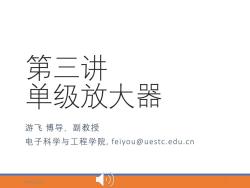
第三讲 单级放大器 游飞博导,副教授 电子科学与工程学院,feiyou@uestc..edu.cn 03/74
2020/3/24 1 第三讲 单级放大器 游飞 博导,副教授 电子科学与工程学院, feiyou@uestc.edu.cn

Why Amplifiers? Amplifiers are essential building blocks of both analog and digital systems. Amplifiers are needed for variety of reasons including: To amplify a weak analog signal for further processing To reduce the effects of noise of the next stage To provide a proper logical levels(in digital circuits) Amplifiers also play a crucial role in feedback systems We first look at the low-frequency performance of amplifiers.Therefore, all capacitors in the small-signal model are ignored! 705/74
2020/3/24 Set 3: Single-Stage Amplifiers 2 SM 5 Why Amplifiers? • Amplifiers are essential building blocks of both analog and digital systems. • Amplifiers are needed for variety of reasons including: – To amplify a weak analog signal for further processing – To reduce the effects of noise of the next stage – To provide a proper logical levels (in digital circuits) • Amplifiers also play a crucial role in feedback systems • We first look at the low-frequency performance of amplifiers. Therefore, all capacitors in the small-signal model are ignored!
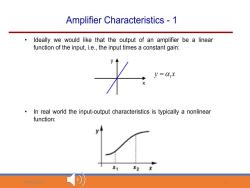
Amplifier Characteristics -1 Ideally we would like that the output of an amplifier be a linear function of the input,i.e.,the input times a constant gain: y=01X In real world the input-output characteristics is typically a nonlinear function: X1 X2 X 03/74
2020/3/24 3
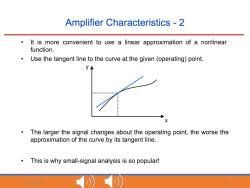
Amplifier Characteristics-2 It is more convenient to use a linear approximation of a nonlinear function. Use the tangent line to the curve at the given(operating)point. y◆ X The larger the signal changes about the operating point,the worse the approximation of the curve by its tangent line. This is why small-signal analysis is so popular! 705/24
2020/3/24 4
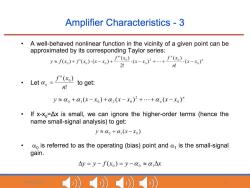
Amplifier Characteristics -3 A well-behaved nonlinear function in the vicinity of a given point can be approximated by its corresponding Taylor series: y*x)+fx)-x-x)+".x-x++"G).6x- 2 n! .Leta,=f"G)to get n! y≈a+ax(x-xo)+a2(x-x)2+…+an(x-x)月 If x-Xo=Ax is small,we can ignore the higher-order terms (hence the name small-signal analysis)to get: y≈ao+a(x-xo)) do is referred to as the operating (bias)point and a is the small-signal gain. Ay=y-f(xo)=y-ao≈△x 03/74 ))))
2020/3/24 5
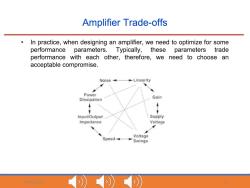
Amplifier Trade-offs In practice,when designing an amplifier,we need to optimize for some performance parameters.Typically,these parameters trade performance with each other,therefore,we need to choose an acceptable compromise. Nolse -Linearity Power Gain Dissipation Input/Output Supply Impedance Voltage Voltage Speed Swings 03/74 )))
2020/3/24 6
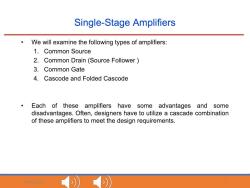
Single-Stage Amplifiers We will examine the following types of amplifiers: 1.Common Source 2.Common Drain(Source Follower 3.Common Gate 4.Cascode and Folded Cascode 。 Each of these amplifiers have some advantages and some disadvantages.Often,designers have to utilize a cascade combination of these amplifiers to meet the design requirements. 03/74 ))
2020/3/24 7

Common Source Basics -1 In common-source amplifiers,the input is (somehow!)connected to the gate and the output is(somehow!)taken from the drain. We can divide common source amplifiers into two groups: 1.Without source degeneration (no body effect for the main transistor): 2. With source degeneration (have to take body effect into account for the main transistor): 尺deg 032W 8
2020/3/24 8

Common Source Basics -2 In a simple common source amplifier: 李Ro gate voltage variations times gm gives the drain current variations, drain current variations times the load gives the output voltage variations. Therefore,one can expect the small-signal gain to be: A=gm·RD 3/4
2020/3/24 9
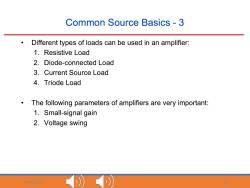
Common Source Basics-3 Different types of loads can be used in an amplifier: 1.Resistive Load 2.Diode-connected Load 3.Current Source Load 4.Triode Load The following parameters of amplifiers are very important: 1.Small-signal gain 2.Voltage swing 3/7 10
2020/3/24 10
按次数下载不扣除下载券;
注册用户24小时内重复下载只扣除一次;
顺序:VIP每日次数-->可用次数-->下载券;
- 电子科技大学:《射频集成电路 RF Integrated Circuits》课程教学资源(课件讲稿)第一讲 CMOS工艺(游飞).pdf
- 电子科技大学:《信号检测与估计 Signal Detection and Estimation》课程教学资源(课件讲稿)Chapter 11 Estimation of Specific Parameters.pdf
- 电子科技大学:《信号检测与估计 Signal Detection and Estimation》课程教学资源(课件讲稿)Chapter 10 Fundamentals of Estimation Theory.pdf
- 电子科技大学:《信号检测与估计 Signal Detection and Estimation》课程教学资源(课件讲稿)Chapter 09 Nonparametric detection.pdf
- 电子科技大学:《信号检测与估计 Signal Detection and Estimation》课程教学资源(课件讲稿)Chapter 07 Multiple pulse detection with random parameters.pdf
- 电子科技大学:《信号检测与估计 Signal Detection and Estimation》课程教学资源(课件讲稿)Chapter 06 Detection of signals with random parameters.pdf
- 电子科技大学:《信号检测与估计 Signal Detection and Estimation》课程教学资源(课件讲稿)Chapter 05 Multiple Sample Detection of Binary Hypotheses.pdf
- 电子科技大学:《信号检测与估计 Signal Detection and Estimation》课程教学资源(课件讲稿)chapter 04 Single Sample Detection of Binary Hypotheses.pdf
- 电子科技大学:《信号检测与估计 Signal Detection and Estimation》课程教学资源(课件讲稿)Introduction、Chapter 01 Preparations.pdf
- 电子科技大学:《信号检测与估计 Signal Detection and Estimation》课程教学资源(教学大纲,何子述).pdf
- 电子科技大学:《敏感材料与传感器 Sensitive Materials and Sensors》课程教学资源(课件讲稿)第八章 电子聚合物基湿度传感器 第二节 电子聚合物基电阻式湿度传感器.pdf
- 电子科技大学:《敏感材料与传感器 Sensitive Materials and Sensors》课程教学资源(课件讲稿)第八章 电子聚合物基湿度传感器 第三节 电子聚合物基电容式湿度传感器.pdf
- 电子科技大学:《敏感材料与传感器 Sensitive Materials and Sensors》课程教学资源(课件讲稿)第八章 电子聚合物基湿度传感器 第一节 电子聚合物基湿度传感器概述.pdf
- 电子科技大学:《敏感材料与传感器 Sensitive Materials and Sensors》课程教学资源(课件讲稿)第九章 专题讲座 第二节 柔性传感器 Flexible Sensors.pdf
- 电子科技大学:《敏感材料与传感器 Sensitive Materials and Sensors》课程教学资源(课件讲稿)第九章 专题讲座 第三节 电子皮肤 E-skin.pdf
- 电子科技大学:《敏感材料与传感器 Sensitive Materials and Sensors》课程教学资源(课件讲稿)第九章 专题讲座 第一节 柔性电子学 Flexible Electronics.pdf
- 电子科技大学:《敏感材料与传感器 Sensitive Materials and Sensors》课程教学资源(课件讲稿)第七章 新型气体传感器 第三节 电子聚合物薄膜气体传感器(质量敏感型有毒有害气体传感器研究).pdf
- 电子科技大学:《敏感材料与传感器 Sensitive Materials and Sensors》课程教学资源(课件讲稿)第七章 新型气体传感器 第二节 无机半导体气体传感器.pdf
- 电子科技大学:《敏感材料与传感器 Sensitive Materials and Sensors》课程教学资源(课件讲稿)第七章 新型气体传感器 第三节 电子聚合物薄膜气体传感器(有机薄膜晶体管气体传感器的制备及特性研究).pdf
- 电子科技大学:《敏感材料与传感器 Sensitive Materials and Sensors》课程教学资源(课件讲稿)第七章 新型气体传感器 第三节 电子聚合物薄膜气体传感器(聚苯胺复合薄膜电阻型气体传感器的制备及特性研究).pdf
- 电子科技大学:《射频集成电路 RF Integrated Circuits》课程教学资源(课件讲稿)第二讲 CMOS器件.pdf
- 电子科技大学:《射频集成电路 RF Integrated Circuits》课程教学资源(课件讲稿)第四讲 噪声 Noise.pdf
- 电子科技大学:《射频集成电路 RF Integrated Circuits》课程教学资源(课件讲稿)第七讲 混合器 Mixers.pdf
- 电子科技大学:《射频集成电路 RF Integrated Circuits》课程教学资源(课件讲稿)第九讲 Power Amplifiers.pdf
- 电子科技大学:《射频集成电路 RF Integrated Circuits》课程教学资源(课件讲稿)第五讲 Transceiver Architecture.pdf
- 电子科技大学:《射频集成电路 RF Integrated Circuits》课程教学资源(课件讲稿)第八讲 Passive devices.pdf
- 电子科技大学:《射频集成电路 RF Integrated Circuits》课程教学资源(课件讲稿)第六讲 Low-Noise Amplifier.pdf
- 电子科技大学:《射频电路理论与应用》课程教学资源(教学大纲)RF Circuit Design - Theory and Application(主讲:游长江).pdf
- 电子科技大学:《射频电路理论与应用》课程教学资源(课件讲稿)第0章 绪论(主讲:游长江).pdf
- 电子科技大学:《射频电路理论与应用》课程教学资源(课件讲稿)第1章 射频通信系统理论.pdf
- 电子科技大学:《射频电路理论与应用》课程教学资源(课件讲稿)第2章 射频通信系统中电路理论(2/2).pdf
- 电子科技大学:《射频电路理论与应用》课程教学资源(课件讲稿)第3章 射频通信传播和天线基础理论.pdf
- 电子科技大学:《射频电路理论与应用》课程教学资源(课件讲稿)第2章 射频通信系统中电路理论(1/2).pdf
- 复旦大学:《模拟与数字电路实验 Analog and Digital Circuit Experiments》课程教学资源(实验大纲,2022,王勇).doc
- 复旦大学:《模拟与数字电路实验 Analog and Digital Circuit Experiments》课程教学资源(PPT课件讲稿,电子教案).ppt
- 复旦大学:《模拟与数字电路实验 Analog and Digital Circuit Experiments》课程教学资源(PPT课件讲稿)基本仪器使用简介.pptx
- 复旦大学:《模拟与数字电路实验 Analog and Digital Circuit Experiments》课程教学资源(PPT课件讲稿)模拟与数字电路实验(上).ppt
- 复旦大学:《模拟与数字电路实验 Analog and Digital Circuit Experiments》课程教学资源(PPT课件讲稿)电子教案.ppt
- 复旦大学:《模拟与数字电路实验 Analog and Digital Circuit Experiments》课程教学资源(PPT课件讲稿)模拟与数字电路实验(下).ppt
- 电子科技大学:《无线系统中的微波与射频 Microwave and RF Design in Wireless Systems》课程教学资源(课件讲稿)ch01 Introduction to wireless system 无线系统介绍.pdf
